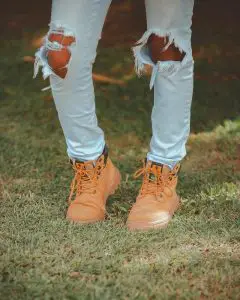How does a world where clothes come from pixels and not textiles sound to you? That’s the future of fashion today with the rise of virtual fashion. Fast fashion started the idea of style being synonymous with ever-changing outfits. Additionally, Fast fashion utilized social media to reinforce this mentality. Research has shown that one in every six young people won’t wear an outfit again if they see it online. This is where digital fashion enters the picture; it allows people to have all the latest and trending fashion outfits in their closets.
However, this isn’t a real closet but a casual closet. You can express yourself with hundreds of new fashionable items on social media while you have a minimalist wardrobe in reality. With virtual fashion, you’re getting the best of both worlds. In this article, we’ll take a look at the digital era and what it means for the future of fashion. We’ll also explore the benefits of virtual fashion. On that note, let’s take a look.
What is Virtual Fashion?
Virtual fashion doesn’t require clothes or anything tangible. The clothes designed with pixels don’t require the use of textiles. Virtual clothing depends on computer technologies and 3D software. Therefore, you won’t ever get to wear any item you buy in the virtual reality world. This doesn’t mean that realistic fashion is dead; you can use the online selection of digital outfits to purchase an outfit you like.
Some designers allow you to send a picture of yourself to a team of 3D designers who then work hard to fit the outfit on your photo. Alternatively, you can download the file and manipulate it using 3D software till it is ready for you to share on various social media platforms.
Many would agree that virtual fashion has been around for some time. Although it looks new and something from the future, curating your digital appearance has always been an integral part of our lives. Beyond looking good for the gram, you’re continually trying to put your best foot forward on LinkedIn. One thing is for sure; we’re all thinking about our online impressions.
For gamers, virtual fashion is the idea of skin; it is the outfit and the weapon the game avatar uses. For most games, a skin can cost you up to $20. They’re simply for aesthetics in most games without affecting players’ abilities. It simply allows you to express yourself and your style within the game. Virtual fashion is quite popular as owners usually resell exclusive skins for thousands of dollars on the internet.
Pioneering Brands in Virtual Fashion
We have many fashion brands in the industry diving into virtual fashion. However, three top brands are at the forefront of this match.
Tribute
This fashion company is based in Croatia and is famous for making contactless cyber fashion. The brand is owned by Gala Marija Vrbanic and Filip Vajda, the head of digital fashion for the company. These two partners started out digitizing their real-life clothing panels with 3D software. Today, the hard work paid off, and they’re a 100% digital brand. They make digital wear using materials that people won’t wear in reality because of the principles.
When people purchase on the platform, they also have to provide their photos. Once they do this, the Tribute designers blend the image with the chosen outfit. Afterward, they add shadowing, life-like elements, and many more features to the outfit.
Fabricant
Fabricant is based in Amsterdam and is a fashion house trying to lead the fashion industry into a new sector of digital clothing. This brand’s primary focus is on creating hyper-real virtual clothing for fashion brands and retailers. For example, the brand worked with Puma on a collaboration. Fabricant’s founder, Kerry Murphy, believes that luxury brand releases will soon be completely virtual. This is because the brand also designs digital couture. Fabricant sold its first piece in a charity auction for $9,500. It is a translucent one-piece created by the creative director of the brand. In addition, you can buy virtual outfits on the brand’s online shop and download free file drops if you want to use them.
One of the ways the brand is different from Tribute is that it fits the garment to the owner’s photo using top 3D software like Marvelous Designer, Houdini, Blender, Cinema4D, and many other industry-standard software.
Happy99
Another pioneering brand for virtual fashion is Happy99. The founders of this brand are Dominic Lopez and Nathalie Nguyen. The founders are not interested in editing photos for customers to post on Instagram. Instead, they believe that wearable AI is a tool that can help businesses create their brand identity. It also opens up the conversation about what to consume for many people. Happy99 allows people to merge digital shoes with physical outfits; it is one of the ways the brand creates a connection with its fans and customers.
Virtual Fashion and Gaming
Virtual fashion is becoming a top niche in the gaming industry and continues to rise in popularity. In 2019, Louis Vuitton collaborated with Riot Games to make skins for the League of Legends World Championship. These screens were original in-game, like many more digital assets available. The brand also created a bespoke travel case for the Summoner’s Cup Trophy. Another brand that delved into virtual gaming was Balenciaga when they collaborated with Epic Games. The collaboration was for original in-game skin for their popular game ‘Fortnite,” whose goal was to provide the players with virtual fashion. In addition, the brand created back blings and many more items the players could express themselves in through their avatars.
Gucci isn’t so far behind, as the brand also collaborated with Roblox in 2021 to create a virtual Gucci Garden. People could view the avatars, try on various outfits and purchase a Gucci item like they would in the real world. However, the clothes were only made to be sold and owned online. Nevertheless, the creation led to someone purchasing one of the bags for $350,000.
Besides popular brands, virtual gaming also allows users to create unique outfits for avatars; this is called digital fashion. A top example of this trend is the Animal Crossing from Nintendo. This game allows players to create similar pieces from their favorite brands. They could then download the designers for their characters. In this game, your avatar can easily match your real-life outfit. This was great for the brand because it’s in line with the goal of virtual fashion, which is encouraging self-expression.
Virtual Fashion on Social Media
Virtual clothes aren’t only for gaming avatars; real people also joined the trend and continue to wear virtual fashion pieces that can share on the internet. The concept of wearing a virtual outfit on the internet is more complicated than buying one for your avatar. To participate in the virtual fashion trend, you’ll have to pick the items you’d like to sell and send a photo of yourself and the piece. All you have to do now is pay for the virtual piece and wait to receive the picture of you super fitted into the cloth.
There are varying virtual accessories, dresses, shoes, and jackets that many more people now utilize on Instagram. The virtual fashion hashtag seems to be growing in popularity as people find fun pieces to showcase.
Virtual fashion is also quite affordable because you can usually find items as low as $20 to purchase. However, some virtual pieces run-up to some hundred dollars. Many people embrace this trend because it provides you with room for creative expression. You can experiment with unrealistic fashion in ways you cannot in the real world. You can show off items you never touched, and if it’s not a great fit, you can simply discard them without worrying about sustainability. Size is also not a determining factor when purchasing a virtual outfit.
Why Virtual Fashion is Taking Over the Industry
There are many reasons why many fashion brands are hopping on the virtual plane; below are some of them.
It is a Sustainable Solution
When compared to fast fashion, virtual clothing is a sustainable solution. Up to 10% of global greenhouse gas comes from the fashion industry alone. In addition, most clothes end up in landfills, causing more environmental issues. Virtual fashion is an opportunity for consumers to enjoy their fast fashion habits without worrying about the environmental impact. When you purchase a piece of virtual cloth, you don’t just reduce the effect of one shirt on the environment; you’re also reducing the waste that you generate when designing and sampling.
It Reduces Production Costs and Marketing Time
One of the reasons why top brands are hopping on the virtual fashion train is that it significantly reduces production costs. By adopting a product innovation, Puma was one of the brands that successfully reduced water storage by 17.4% through their virtual cloth collection. The brand also shared that they reduced their marketing and overall cost by 30%.
It is a Gender-Inclusive Concept
One of the reasons people seem to love virtual fashion is because anyone, regardless of their body type, gender, size, and any other limitations, can wear anything they want. This concept gives a new meaning to gender-inclusive fashion. Most virtual fashion brands create sizeless, genderless clothes; it is truly a universal concept.
There Are Many Possibilities for Expressing Yourself
Virtual fashion also ensures that its users are not limited by physics and graphics. Designers and consumers alike can design and experiment with texture and many more limitations. You can change your textile according to mood or even wear one made of water. Virtual fashion opens the door for self-expression as people continue to look for abstract clothing that reflects how they want to be seen.
Final Thoughts
Virtual fashion is a more accessible trend in the fashion industry as designers no longer have to worry about their carbon footprint as they do in the traditional fashion industry. It is easier to create and fit in with new trends as people show off their personal style through virtual fashion on social media. With many people devoting themselves to the online space, technology would continue to evolve, and times would change. Virtual fashion is a natural product of these times, and it will continue to evolve in several ways with technology evolution.







